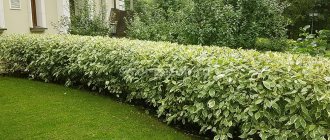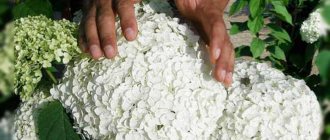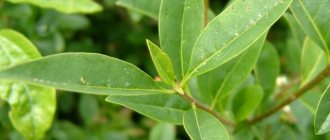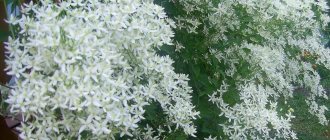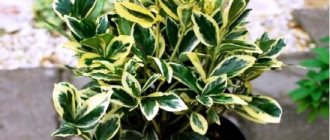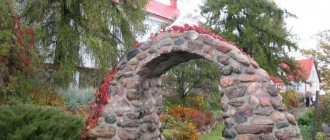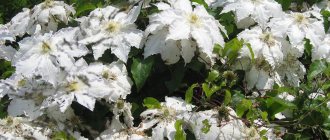Practical use of vines on the site
Creepers are primarily used to decorate unsightly objects on the site, such as the walls of a barn or an old fence.
Also, many annual vines themselves are capable of acting as a fence if they are allowed to climb along a chain-link mesh. For example, morning glory or sweet pea will very quickly turn such a simple fence into a real hedge. In addition, fire red or kobe beans will protect the area from prying eyes. The rather large leaves of these fast-growing vines create a tall green screen.
Annual vines are also good because they help gardeners fill voids in flower beds. While perennial plants are still growing and do not fully occupy the space allotted to them, climbing plants will help decorate the flowerbed.
Actinidia
This climbing vine is also called frost-resistant kiwi, but if you plan to get useful fruits from it, you will have to plant seedlings of different sexes. A tree-like vine needs reliable support, which can be a tree or hedge growing nearby. When growing, follow the basic rules.
- Location – south side of the site;
- The soil is slightly acidic or rich loam;
- Fertilizer - loves mineral fertilizers and organic matter;
- Pruning – formative and sanitary in the spring.
Actinidia has recently become a very popular vine. This is a very powerful and fast-growing perennial vine with heart-shaped (in the Kolomikta species) or oval (in the Arguta or Polygam species with leaves, small but very delicate, and fragrant white drooping flowers, completely covering the shoots in the spring.
Actinidia kolomikta is decorative throughout the season, but especially during flowering, when in addition to the flowers, the tips of the leaves turn white, then they turn pink and become crimson. Since this process is gradual, the vine has leaves of all shades, which looks very elegant. If your garden has both female and male plants, then after pollination a bonus to this beauty can be a harvest of very tasty berries, similar in taste to kiwi. The only drawback is the frequent freezing of flowers and leaves during return frosts, especially male flowers.
Actinidia will quickly recover, but there will be no fruit. Actinidia acuminata, or arguta, has larger, dark green foliage and male and female flowers on the same plant. This species has been living in my garden for more than 10 years, often freezes to the snow level, quickly recovers in the spring, almost does not suffer from return frosts, but has never bloomed.
Features of creating a hedge
If you are planning to create a living fence from climbing plants, you should take care of the base for them. Vines can be grown along an existing fence, especially if it is unattractive, or a new one can be created.
Put up a new fence or revive the old one – it’s up to you
Chain-link fence or any other
For climbing plants, chain-link mesh is an ideal base. Its structure allows it to cling tightly to the cells. A serious disadvantage of such a fence is its relative fragility: if necessary, it can be opened.
In addition, under the weight it may sag or fall. If you plan to plant perennials, it is better to make a fence from a different material.
Many climbing varieties perfectly weave almost any surface, so any fence will fit under such a hedge.
Instructions for creating a hedge
You need to start creating a hedge from the base.
If there is no fence on your site, you can quickly make one from a chain-link mesh. To do this, you need to dig metal poles into the ground and stretch a mesh between them.
If you plan to create a more durable structure, it is recommended to concrete the pillars and replace the chain-link mesh with stronger structures that should be welded to the pillars.
Stone and wooden fences are also suitable as a base for hedges. To secure climbing plants, it is recommended to drive in hooks and pull ropes.
| Important points | Prepare the soil for planting: loosen it, apply fertilizer in advance |
| Plant taking into account that varieties will grow over time, especially perennials |
What varieties are suitable as decor for a fence?
When creating a unique hedge using climbing plants, think about combining them. Different varieties of the same species look beautiful, differing in shades of foliage or flowers (climbing roses work well).
Planting flowering annuals to perennial non-flowering plants looks impressive. This allows you to revive the hedge. You can combine ivy and bright nasturtium, periwinkle and kobeya, or multi-colored bindweed.
Which ones are not suitable for hedges?
When creating a hedge, remember moderation. You should not plant several types of flowering climbing plants nearby. It looks cumbersome, and the plants in the neighborhood are not always comfortable.
Ivy in landscaping can destroy flowering neighbors
They begin to fight for survival, displacing each other.
It is not recommended to plant ivy next to flowering plants; it is aggressive and can destroy its neighbor.
Too heavy specimens can collapse a light hedge, so trim them in a timely manner.
Beware of parasitic plants, such as dodder, which attach themselves to the host plant, grow quickly and can destroy everything around it.
If you find at least one parasitic plant in a hedge, try to remove it and treat the soil and neighboring plants.
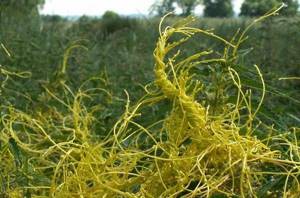
Dodder is a dangerous parasite for your hedge
A hedge will decorate any area. And your imagination, effort and patience will make it a unique element of landscape design.
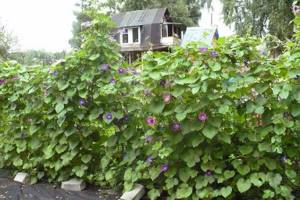
How to plant a hedge
In order for climbing vines to grow well in the garden, the soil should be prepared in advance. The best time for these purposes is the end of September-early October, that is, when the foliage begins to fall rapidly. In this case, the vines will have time to strengthen their roots before frost, and the soil will settle well. Then you need to do the following:
1. Dig a small ditch along the border of the fence (or other place you need). Its depth should not exceed 0.5 m. We select the width of the trench depending on the number of rows for planting. On average, the width of one row is about 40 cm.
2. You need to put a good fertilizer at the bottom of the ditch - it can be manure, peat or compost. It is advisable to plant seedlings that are about 2 years old. Depending on how quickly the climbing plant grows, the distance between seedlings when planting depends. Fast-growing vines should be planted away from each other.
3. Supports of low height should be installed along the trench so that the seedlings trudge upward from the beginning of their growth.
4. Every year, fertilizers should be applied to the roots of climbing plants, preferably in liquid form. This procedure is carried out every spring.
5. To strengthen the hedge, you need to remove a few branches every season by pruning them. This way the climbing perennial plant will become massive and will quickly weave around the fence.
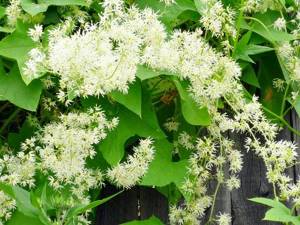
If the planting of climbing vines in the garden on the site is carried out correctly, then after a few seasons the fence will be completely hidden under a dense flowering carpet, which will delight with its splendor and will protect from unnecessary glances, sometimes not very favorable... And who is stopping them from bringing the same beauty to dacha?
Climbing annuals
Such ornamental plants are an excellent alternative to perennials for creating a hedge. Their life lasts from spring until the first frost. The peculiarity of these plantings is that many varieties reach great heights. This allows you to use plants as decoration for any fences. Annuals have long stems, devoid of shoots, and are characterized by abundant flowering. They belong to the category of capricious ones.
Among the most common are:
- decorative bean - is an annual plant with red-orange flowers, afraid of frost, so planting is carried out in May;
- sweet pea is an annual with a delicate aroma;
- kobeyu is a liana-like plant that blooms with bells and looks like a waterfall;
- nasturtium - a decorative annual with velvety lemon-colored flowers, the height of which reaches 4 meters;
- Morning glory is an annual plant with crimson and purple flowers, which is planted in open ground in early spring. The plant is not capricious and does not require additional care.
Criteria for choosing climbing plants for landscaping a fence
When selecting plants, you need to take into account many parameters, incl. height of the fence, desired growth rate, whimsicality and possibilities for further care. All climbing plants can be divided into perennial and annual. The first group is more suitable for high fences, the height of which exceeds 1.5 m. Such climbing plants for a fence can fill all surfaces in 2-3 years. If the height of the fence does not exceed 1 m, you can use annual vines.
In addition, when choosing plants, you need to take into account the time to obtain results. If you are planning to hold a holiday in your house and you need to decorate the fences beautifully, you should pay attention to fast-growing vines, which allow you to create a green fence in just 1.5-2 months.
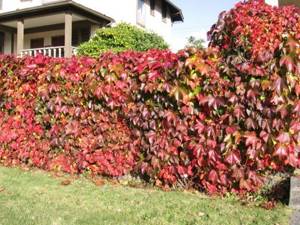
Some plants climbing along the fence produce beautiful large flowers and tasty fruits. Hedges decorated with them look impressive, but in most cases such plants are whimsical and may not grow on all types of soil. In addition, the use of such loaches is not recommended when allergy sufferers live in nearby houses. In this case, it is best to plant vines that produce many shoots and dense foliage, but do not produce flowers.
Many loaches are unpretentious in care and do not require the creation of specific conditions for planting. They are suitable for those who do not have the time to provide careful maintenance to their hedges.
Types of climbing plants
There are a huge variety of groups of climbing plants. They are formed according to various characteristics. The largest groups are perennial and annual.
Perennials are more popular because they require less care. They need solid support. A gazebo or fence will do. The most popular perennials are: climbing rose, clematis, honeysuckle, virgin grapes, campsis.
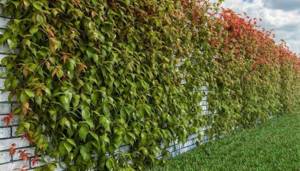
girlish grapes on the fence
The climbing rose is popular among amateurs and professionals. It is prickly, but has gorgeous flowers of various colors. It has the ability to please the owner with its flowers for a very long time, in return it requires very little attention. It is completely undemanding to care, can survive drought, and even during it will pamper the garden with its flowers from early summer to late autumn.
Climbing rose on the fence
Caring for this beautiful plant is as simple as possible: you need to plant the bush, water it, and fertilize it several times during the season. In autumn, trim off unnecessary shoots. If the support is metal, it is better to remove it to avoid the death of the plant.
Kampsis. Blooms from early summer to early autumn. The flowers have warm shades: orange, yellow, golden, scarlet. In order for this beautiful plant to survive the winter, it needs to be insulated. Not suitable for recreational areas because it attracts birds and insects.
Campsis on the fence
Clematis. It is capable of creating a continuous carpet during flowering. Proper care will prolong flowering until late autumn. Clematis requires a lot of sun and space, so you need to plant it in an open and sunny place. For example, a fence, a gazebo, a trellis. You can plant it near the house, then it will cover the entire building.
Clematis on the fence
Honeysuckle. Loves shade. It has a peculiar aroma that can attract butterflies. It does not require much care, all you need is just to give it support and point it in the right direction.

Honeysuckle on the fence
There is also a group of fast-growing plants. These include: rose zephyrin drowchin, bougainvillea, sweet pea, morning glory, nastrutia.
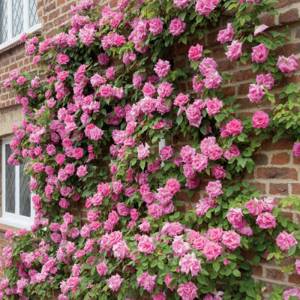
rose zephyrin droukhin on the house
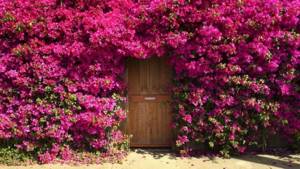
bougainvillea on the fence
Nastrium. It is distinguished by bright blooms of yellow, orange, burgundy or red. These colors look great against green foliage. Plus, it can be planted on flat ground and it will cover it. Flowering continues from the first half of summer until September.
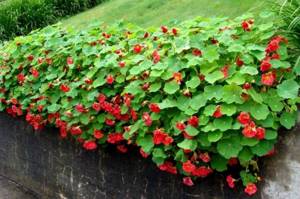
Nastrium on the fence
Morning glory. The flowers are saucer-shaped. May be blue, red, purple or yellow. It is completely undemanding in terms of planting location and care - it can do without water for a long time.
Morning glory on the fence
Sweet pea. Blooms from summer until late autumn. However, it requires care. It will grow well in a sunny area, dry soil. In addition, it needs to be fertilized once or twice a month.
Sweet pea
Winter-hardy climbing plants
In the climate of the middle zone, it is especially important that perennial plants are able to survive the cold, otherwise they become annuals. The most popular winter-hardy plants: Schisandra chinensis, petiolate hydrangea, round-leaved tree pliers, actinidia
Schisandra chinensis on the fence petiolate hydrangea on the fence
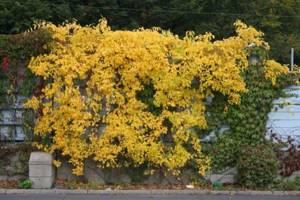
round-leaved wood plier on the fence actinidia on the fence
Annual plants are good for their fast growth. Their main difference is their heat-loving nature and inability to survive in cold conditions. That is why gardeners have to plant them every season. But this type of plant grows very quickly and gains color. These include kobeya.
07a7f84b87754aae17dcf4e387261b7c.jpe 3d534aec58d2c4ee47426478d48a257f.jpe 1176e64e6fc02d1bb7c44fbd59f9885b.jpe
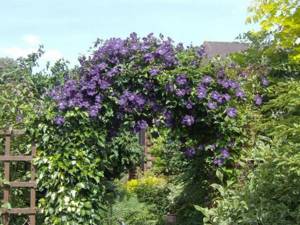
kobeya
Evergreen climbing plants. They are popular when decorating hedges, fences, columns, and gazebos. Other types of climbing plants are able to attract the eye with their flowering and aroma, while evergreens can surprise with decorative leaves and constant color even in winter. These include: ivy, euonymus, periwinkle.
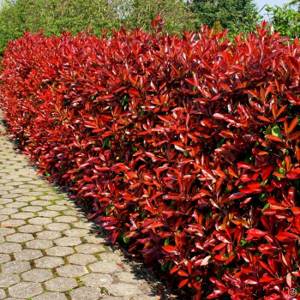
Euonymus on the fence
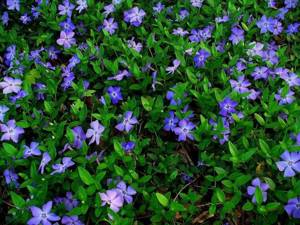
Periwinkle
Ivy is one of the most common plants. It grows freely outside the garden, which indicates its high degree of survival and unpretentiousness. As a rule, ivy lives in shady areas. With the help of aerial roots it can climb to great heights. The length of the vine can reach a couple of tens of meters.
ivy on the fence
Unpretentious climbing plants
For those who visit the dacha from time to time, it is important that the plants do not require much attention and survive with modest care
Forming a hedge from trees
To create a beautiful hedge of greater height, trees are actively used. We present the 7 most common options.
1. Purple willow
Tree-shrub, low, with silvery leaves, rounded crown, up to 1.5 m high, forms a low but beautiful, geometrically regular hedge. Loves light, but is resistant to drought and winter cold.
2. Holly willow
Grows on poor soils, height – up to 8 m, does not require special conditions for growth. Willow is easily adaptable; it needs to be pruned 2 times a year - at the beginning of the season and at the end.
3. White acacia
Valued for its pleasant aroma and beautiful, snow-white color. Suitable for problematic soils - saline, poor. The advantages of acacia include: resistance to drought, decorativeness. The tree “does not like” harsh winters and requires warmth and light.
4. Aspen
To create a hedge, you need young shoots that are no more than a year old. To create an effective, impenetrable fence, you need to intertwine the branches together. Requires minimal maintenance and pruning. Any soil is suitable.
5. Eucalyptus
The exotic tree is the fastest growing of all those listed. The plant is unpretentious to soil and tolerates drought. Trimming helps control the shape.
To form a hedge, the following varieties are used: lemon or few-flowered eucalyptus and the Gunni variety (Gunna or Ganna).
- The low-flowering type is a full-fledged tree that is used in landscape design. It grows in nature in Australia, reaching several meters; the indoor and outdoor versions are low, with silver-green leaves. Likes plenty of watering
- Gunni is an evergreen plant, rich in essential oils, can withstand low temperatures, and has healing, antiseptic powers. The height of the tree is small or medium, the leaves have a beautiful bluish-green color, and the branches are spreading. Young leaves are very fragrant, blue in color, the surface is waxy - in the bush format they will continue to be so
- Lemon eucalyptus: in nature reaches 35 m in height, cold climates are poorly tolerated, therefore they are suitable only for regions with a consistently warm climate, without frost.
In order for the tree to grow more actively, you need to ensure that the soil does not dry out.
6. Field maple
Neat trees, you can get a fence up to 4 m high, grows well in the shade, better in a sunny area, retains decorative properties throughout the warm period. Twice a year the maple is pruned - woody branches are removed. You can cut your hair without fear and give it the desired shape. Does not grow on acidic soils.
7. Lawson cypress
North American plant, in nature - up to 80 m tall, decorative varieties - up to 30 m. The crown is dense and beautiful, forms a dense hedge, grows quite quickly, holds its shape well, suitable for classic, regular landscape design. Of all the options, cypress is the most popular in Europe.

8. Thuja Brabant
It is this version of the fence that we often see in movies near country houses with well-groomed plots, designed geometrically correctly and strictly. The classic type of planting allows you to form a dense fence and looks strict and solid. Height – up to 3 m.

For a small dark area, this is not the best option, as it provides strong shading.
It grows quickly and holds its shape well after being cut. Per year, under optimal conditions, they grow by 1.5 m. Not recommended for regions with harsh winters.
Sowing annual vines
Most annual vines should be sown for seedlings in early March - mid-April. When the seedlings sprout, they should be carefully thinned out (usually this is done 2-3 weeks after sowing the seeds). Young plants should be tied to a support from an early age. If the plant does not branch well, you can pinch off its top.
| Liana | Sowing time | Flowering time |
| Kobeya climbing | February - for seedlings, May-June - in open ground | From July until the first frost |
| Sweet pea | May – in open ground | July-October |
| Fire red beans | May – in open ground | From July until the first frost |
| Foreign nasturtium | April - for seedlings, May - in open ground | From June until the first frost |
| Beautiful nasturtium | April - for seedlings, May - in open ground | From June until the first frost |
| Large nasturtium | April - for seedlings, May - in open ground | From June until the first frost |
| Ipomoea purpurea | April - for seedlings, May - in open ground | July-October |
| Morning glory blue | April - for seedlings, May - in open ground | July-October |
| Morning glory quamoclite | April - for seedlings, May - in open ground | July-October |
| Decorative pumpkin | April - for seedlings, May - in open ground | July-October |
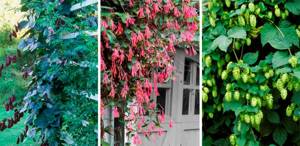
5e410aab9333aaff48894bd72104798f.jpe
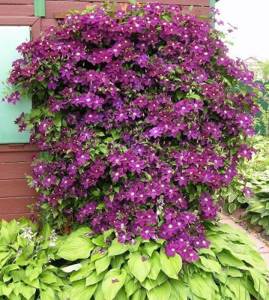
ab7dc7c6bfff2220ecae2af7b34f5572.jpe

fe74a28b49de0eb673edf3e7541cec36.jpe

863f4f9335ab58e2f29b9635026fc63d.jpe
Annual vines in the garden are excellent ornamental plants that can be used to decorate a gazebo or disguise a not very attractive building in one season. Choose a vine that you like, and there will always be a place for it on the site.
Benefits of perennial vines
Despite the fact that perennial vines fully reveal their beauty only 2-3 years after planting, they also have an impressive list of benefits.
- Frost resistance. Climbing perennials grow in one place for several years and at a time when many garden crops retire, the vines color the garden with crimson and gold colors.
- Practicality. Vertically growing vines do not require much space for planting. Overgrown shoots create an excellent curtain from wind, sun, dust and street noise. In addition, dense thickets of vines are an excellent place for nesting birds. Such close proximity to active exterminators will get rid of many insects and parasites.
- Endurance. Even if the shoots die during a particularly harsh winter, in the spring the plants will produce new growth from the roots.
- Decorative. Perennial climbing vines are a real find for garden designers. Plastic plants are used to decorate fancy structures, for landscaping gazebos and pergolas. They perfectly hide flaws and imperfections in structures (garden sheds, garages, basements, etc.).
Selection of perennial plants for vertical gardening
Currently, a variety of floral and deciduous decorative vines are used in landscape design. Let's take a closer look at the most popular types and their features.
- High or low green hedges divide the garden landscape, sometimes becoming the backdrop for beautiful decorations or flower beds.
- They effectively hide uninteresting views behind a fence or outbuildings - a compost heap, a chicken coop.
- Indispensable wherever there is too little space for planting large trees, for example, in miniature plots.
- Unlike stone or iron fences, they provide oxygen and create a useful microclimate in the garden, reducing the amount of dust, air pollution, and noise.
Evergreen and deciduous perennial vines
For the shady corners of the garden, you need unpretentious plants that form a green mass. On my site, an openwork welded arbor is entwined with wild hops brought from the forest. Frankly, I’m tired of fighting him. The roots spread in different directions. Neighbors prefer more noble plants, I give a description of some vine crops that deserve attention.
Ivy
In European countries, the evergreen shrub reaches 30 meters in height. In temperate latitudes such splendor cannot be achieved. But 5-6 meters is a completely achievable height. 2-3 year old seedlings take root well. It is better to plant them in spring in soil amended with organic matter. In summer, ivy is pruned, sometimes the shoots freeze. It’s worse when the root system suffers from frost. In winter, the soil on the plantings is mulched, creating a layer of up to 15 cm. In winter, it is advisable to carry out snow retention measures.
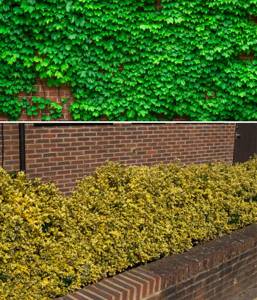
Fortune's ivy and euonymus
Euonymus Fortune
Of all the varieties of creeping shrubs, Emerald Gold is best suited for trellis growing. The oval green leaves with a light yellowish edge turn a rich brownish-red color in the fall. In too shady areas, the variegated border of the leaves disappears, they become monochromatic. The culture is valued for its green cover, but in the spring the euonymus pleases with its numerous buds. Flowering will be abundant if complex fertilizers are added to the soil annually and sunlight is given access to the vine.
Maiden grapes
It is advisable to plant it on the leeward side, in a sunny area. Curly large leaves and loose clusters of berries decorate the garden in summer. At the first frost, the foliage begins to turn red and acquire a purple tint. Young bushes are demanding when it comes to watering. Adult plants are less whimsical. In winter, plantings are covered with branches and dry grass. Some gardeners install thick acrylic over their plantings. The crop rarely freezes, but is prone to damping off in areas of spring flooding. It is advisable to make 20 cm drainage in planting holes.
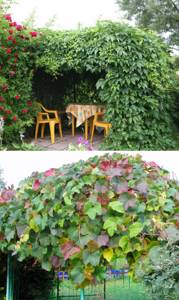
Maiden and Amur grapes
Amur grapes
If you want to get “two in one,” green your garden with this winter-hardy vine. In addition to a gorgeous crown, you will receive clusters of round purple edible berries. During ripening they look decorative. As the temperature drops, a reddish-brown pigment predominates in the leaf blades. The plant is unpretentious to the soil, it requires nitrogen-phosphorus fertilizers, potassium is added only during the period of waxy ripeness of the berries. Excess calcium inhibits Amur grapes, they develop worse.
Woodplier
The liana climbs walls using rigid hooks. It grows into soft wood, slate. Wood pliers are best planted near brickwork. Shiny leathery leaves the size of a chicken egg form a dense crown. In spring, white caps of flowers appear on the bush. In autumn, bright red berries ripen from them; they look advantageous against the background of yellowed foliage.
For full growth, the crop is fertilized three times a season with organic matter and mineral complex fertilizers for flowers. For the winter, it is enough to cover the roots; they are mulched with peat, covered with a layer of straw, dried shavings, spruce branches - it holds snow well. With good care, the vine increases by 2 meters.
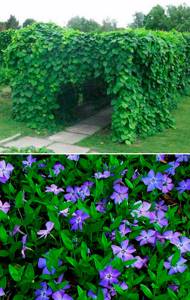
Tree pliers and periwinkle
Features of climbing plants
Planting perennial climbing plants on a site serves several functions.
- Decor. Climbing plants will decorate fences, arches, gazebos, and building walls well.
- Disguise. Climbing plants will help hide compost pits, old unsightly buildings, and barrels of water from prying eyes.
- Protection. By wrapping around the walls of a building, plants will protect it from dust and improve sound insulation.

When choosing climbing perennials for your site, you must take into account that they are divided into groups: creeping (used for landscaping horizontal surfaces), climbing (they have special suction cups on the stem with which they are attached to vertical surfaces) and clinging (they must have supports) .
Before planting, you should consider the support structure. Its strength depends on the type of flower. For plants with thin stems, you can stretch thin cords or plastic nets; with thick ones - more durable metal or wooden structures. For some plants, in addition to support, special clothespins are needed to help secure the shoots to the support.
How to choose climbing fast-growing plants for a fence?
Now let's look at the types of climbing plants. If you don’t visit your summer cottage as often as you would like, then the perennial is for you. They are not demanding in care, plant once and that’s it – a beautiful fence for many years. Let's look at some of the most common ones:
Maiden grape is a beautiful, climbing plant with medium-sized leaves. A distinctive feature is the interesting color of the leaves, which change color from bright green in summer to crimson in autumn. At the same time, black berries ripen, which will also serve as decoration. The grapes are quickly accepted, grow for a long time and do not require special care other than pruning, since the height of the branches can reach up to 20 meters.
Maiden grapes
Clematis. One of the most popular plants in many summer cottages. The main advantage is the flowers in white, pink or purple shades. Winters well, loves sun and sufficient moisture.
Clematis
Ivy. This climbing fast-growing plant is the sword of many summer residents. It is a tree-like vine with neat, green leaves. Ivy grows quite quickly, does not require care, and grows well both in the sun and in the shade. This plant looks very impressive on a house, which immediately becomes cozy and fabulous.
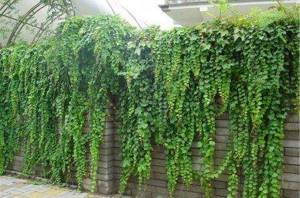
Ivy
Climbing rose. A beautiful plant with delicate flowers, the aroma of which will delight you for a long time. Rose does not like dark places and rocky soil, so it is recommended to plant it only in fertile soil, taking care of watering. The only thing that needs to be taken into account is that the plant takes up quite a lot of space both in width and in height, so it is better to plant the rose about one meter apart.
climbing rose
For those who visit the dacha quite often and want to change the climbing plants on the fence every year, we suggest you pay attention to the most common unpretentious plants of the same age:
Morning glory. A very popular plant among gardeners. Attracts with blue, pink and white flowers that bloom from May to September.
morning glory
Kobeya. The main difference is the dense, green foliage and large bell-shaped flowers from which the stamens protrude. Characterized by rapid growth. Loves light, warmth and abundant watering.
Kobeya
Sweet pea. Didn’t know that peas are a climbing plant? Then you will be even more surprised how beautifully it grows. The only thing to remember is that peas attract bees.

3fa53ed3a49090f033516929b1f46f1f.jpe 0bb6b0a412dd6c44628cca612a32d5c1.jpe
Decorative pumpkins. Tree-like vines with a huge number of small, bright pumpkins, a variety of shapes and colors. Great decoration for your fence!
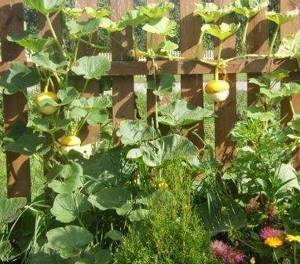
Decorative pumpkins
Planting fast-growing climbing plants for a fence is easy. The good news is that caring for them is not difficult at all. We hope that our tips will help you grow plants in your summer cottage that will decorate your fence.
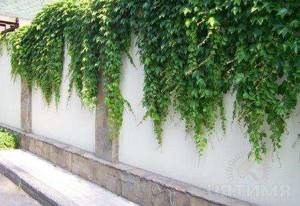
Recommendations for planting climbing plants
Requirements for soil, climatic conditions and planting technology vary from species to species. Let's look at them in more detail in the section describing various types of perennial and annual plants. However, there are a number of rules that will need to be followed in any case.
To plant any fence, you will have to prepare a ditch. Typically, the depth and width range between 40 and 70 cm, depending on the type and age of the seedlings. Perennial plants are planted when they are at least three years old, and annual plants are planted from seeds. With double-row planting, the required ditch width is twice as large. In this case, the plants should be placed in a checkerboard pattern.
The bottom of the prepared ditch must be provided with drainage from a mixture of gravel or broken bricks with sand (at least 10 centimeters thick). With it, the root system of plants will not “get wet” and rot. You can put a small layer of top dressing on the drainage - compost or leaf flour. The appropriate type of fertilizer depends on the preferences of a particular plant, the climatic and geological characteristics of the site.
Selected young and healthy seedlings with a strong root system, without rot and signs of disease, are then placed in a ditch at a distance of 40 cm to one and a half meters from each other. The planting step depends on the desired density of the hedge and the species' requirements for free space.
Cover the roots with a better prepared nutrient mixture of selected soil, peat and other fertilizers, the choice of which depends on the “tastes” of the plants being planted and the characteristics of the site. Young shoots are provided with vertical supports up to 35 cm high. When the main trunk gets stronger and the shoots are fixed to the base, the support can be removed.
Perennial climbing vines
Those who do not want to invest a lot of work and time on the annual sowing of vines and caring for them are recommended to choose perennial vines to form a hedge in their summer cottage. Perennial vines are evergreen and can grow in one place for several years. In addition, they do not require much time and labor. Such perennials include ivy, ornamental grapes, wisteria, hops, and ornamental roses.
It is worth noting that during the first year after planting, the sprouts of perennials are quite fragile and weak; they must be provided with reliable support. But over time, the root system of the vines strengthens, it becomes more powerful and strong, and they independently begin to cling to the fence, creating a thick green blanket on it.
Let's take a closer look at the most popular vines for hedges:
Climbing rose. It has large and bright flowers, behind which the leaves are almost invisible
It is this property that the rose attracts the attention of the owners. In addition, climbing roses can bloom for a long time and do not require careful care.
Care involves only regular pruning of the bushes in the autumn and insulation of the rose for the winter. Roses easily survive spring frosts.
Honeysuckle. Many gardeners choose this plant to decorate their plots not only because of its beautiful flowers, but also because of its pleasant sweet aroma. In addition, honeysuckle is a rather unpretentious plant; it can grow not only in sunny areas, but also in the shade. It is also worth noting that it grows quickly and strongly, so the bushes need to be shaped and the shoots trimmed.
Climbing grapes. This liana is one of those ornamental plants that are especially beautiful in the fall, when its red and yellow leaves stand out brightly against the background of the fallen crown of other vines. In addition, climbing grapes have another advantage: tenacity. It successfully independently entwines its lush crown not only with fences, but also with any arch or gazebo. Very often this vine is used to weave arbors, as they look quite attractive, they are comfortable and cool in the summer. Basic care for climbing grapes involves cutting off excess branches, as well as forming a neat crown.
Clematis. Gardeners most often choose these climbing vines due to their bright, large inflorescences. Clematis grow quite quickly and strongly, while forming lush green carpets on the fence. It is worth noting that clematis need more careful care. These vines love to grow in the heat, and they will bloom best in a sunny place protected from the wind. Care also involves regular pruning of shoots. In addition, the vine needs constant feeding with fertilizers; only in this case will it bloom and grow well in your summer cottage.
Ivy. It can be called one of the best options for creating an evergreen hedge. Ivy will feel quite comfortable both in the sun and in the shade. It quickly entwines the wall with its green and thick mass, which will create coolness and comfort in your area. Regarding care, ivy is quite unpretentious; it can independently find support thanks to its suction cups. Another plus is that greens can enrich the soil with nutrients, which allows annual vines to develop faster and bloom better.
Hop. Many gardeners consider this vine to be a harmful plant. But hops are quite undemanding to care for and grow very quickly. It has fairly large leaves and fragrant flowers, which eventually turn into cones. The green vine is evergreen; it weaves itself around fences throughout the year. Wisteria. This vine is more capricious than the previous ones. It likes to grow in bright areas; wisteria will not bloom in the shade. If you provide her with good care, she will thank you with a lush green wall, which will be decorated with multi-colored inflorescences.
Perennial vines with decorative foliage
Euonymus
A very interesting climbing shrub with decorative multi-colored small leaves, suitable for planting in the sun and partial shade, fits well into small gardens. The shrub is often planted along fences and fences.
Euonymus climbing (creeping) is a type of climbing shrub from the euonymus family.
Blooms from May to June. The fruits ripen at the end of September. The plant is frost-resistant.
| Height | 1-3 (9) m. |
| Stem | The shoots are thin, green or reddish, four-pointed. The bark is dark green, grooved. |
| Leaves | Oval, up to 10 cm long, on short petioles, finely toothed or jagged along the edge. Green, pink-red in autumn. |
| Flowers | Four-petalled, white, small (1 cm diameter), collected in clusters. |
| Fetus | Poisonous to humans. Contains white seeds. |
Kirkazon largeleaf
Large-leaved Kirkazon (Aristolochia macrophylla) is the most valuable species of the Kirkazon genus. It grows quickly, produces twisting shoots that grow up to 2-4 m per year. It creates an impenetrable cool shady cover - it was used to grow gazebos on noble estates (which is why it is sometimes called the “noble vine”). Frost-resistant.
| Height | 10 m |
| Leaves | The main decoration of the shrub is the impressively large heart-shaped leaves, long (up to 30 cm), overlapping each other, forming dense green walls. |
| Flowers | It blooms in May-June with interesting tube-shaped flowers hidden between the leaves. |
| Fetus | In our climate it rarely bears fruit (the fruit resembles a small cucumber). |
Kirkazon produces a lot of green mass and requires strong supports and a durable fence. This is a hardy, long-living loach, grows better in partial shade, tolerates shade, and does not like very windy positions. Prefers fertile, moderately moist soils. In sunny and dry places it is often affected by spider mites. After planting, it takes 2 years for the bush to take root and begin strong growth.

Akebia quintuple
Quintuple akebia (Akebia quinata) is a perennial 5-10 m high, belonging to the family Lardizabalaceae. The plant is native to Asia and grows in China, Japan, and Korea.
| Height | 5 -10 m |
| Leaves | Decorative, finger-shaped, on long petioles. |
| Flowers | Sweet-smelling, star-shaped, collected in clusters - males are light pink, females are dark purple. |
| Fetus | Cylindrical, exotic in shape (resembling sausages) with 2-6 flat stalks. |
Akebia blooms from May to April. It bears fruit in autumn (September to October). The plant grows by about 1-3 m per year.
Prefers sunny places, can also grow in partial shade. Grows best in permeable, slightly moist soils. It may freeze in severe winters, but in this case it usually grows back from the base in the spring. Maintenance includes weeding and pruning. In the garden, Akebia quinquefolia is used for landscaping pergolas, gazebos, walls and fences. The liana thickly wraps around all the supports. When sown freely, it can grow as a ground cover plant.

Maiden grape five-leaf
This plant is native to North America and belongs to the Vitaceae vine family. A strong, persistent vine, grows quickly - about 1-2 m per year.
| Height | 10–20 m |
| Shoots, stem | The shoots rise upward with the help of aerial roots and forked, curved tendrils. Young shoots are reddish. |
| Leaves | They consist of 5 oblong, jagged and pointed leaves, 4-10 cm long. The upper surface of the leaf blade is green, the lower surface is grayish. In autumn the leaves turn orange, purple, and red. Unfortunately, the beautiful grape leaves fall off in the fall. |
| Flowers | Inconspicuous, greenish, develop in late July - early August, honey-bearing. |
| Fetus | The berries are round, dark blue with a waxy coating, 5-6 mm in diameter. Ripen in September-October. |
Can grow in sun, partial shade, shade, in average, well-drained soils. However, specimens planted in a sunny place change color to intense red in the fall.
Maiden grapes are suitable for landscaping fences, walls, gazebos, pergolas and other supports. Completely frost-resistant, undemanding. Can be planted on balconies, terraces, in large boxes or other containers.

Coignier or Japanese grapes
One of the most beautiful and fastest-growing plants with spectacular large leaves that turn crimson in the fall is the Coignier grape. It grows very vigorously, growing by 4 m annually.
| Height | 12 m |
| Shoots, stem | The shoots are thin with long sticky tendrils. Young shoots have red hairs. |
| Leaves | Decorative, large 30-50 cm, round, thick, heart-shaped at the base, with 5 weakly defined lobes, green at the top and with gray or brownish hairs at the bottom. In autumn they turn scarlet. |
| Flowers | Inconspicuous, bisexual, light green, fragrant, develop in May-June. |
| Fetus | Small, on average 8 mm, black-purple, ripen in autumn. |
Suitable for landscaping high fences, gazebos, strong supports.
Frost resistance: -30 °C. Water requirements: moderate humidity. Preferred soils: neutral, fertile.

Coastal grapes
Coastal grapevine (Vitis riparia) is a vigorous loach that rises with tendrils. It grows by 2-4 meters annually.
| Height | 10 m |
| Leaves | Three-lobed, large (15-18 cm long), tightly covering the plant. Green in summer, yellow in autumn. |
| Flowers | Inconspicuous, intensely fragrant (blooms in May - June). |
| Fetus | Dark purple fruits. |
Of all the vines, it is very unpretentious and the most resistant to salinity. Tolerates urban conditions very well.
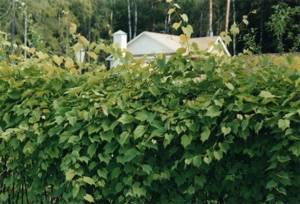
Tree pliers round-leaved
Celastraceae – grows up to 12 m, 1-4 m per year. Position: any.
A very vigorous plant is the round-leafed tree plier (Celastrus orbiculatus), climbing its stems around supports. Where the vine cannot find support, it forms dense thickets.
a brief description of
| Height | 10-15 m |
| Leaves | Round or ovoid, 5-10 cm long, short pointed at the top, light green, turning yellow in winter. |
| Flowers | Blooms with inconspicuous white flowers. |
| Fetus | In autumn, pollinated female flowers produce yellow or red fruits, interesting for their decorative value in the winter landscape. |
It is undemanding, but prefers to grow in a sunny place, tolerates average soils, and tolerates periodic drying out well. Due to its invasive nature, its growth should be controlled; wood pliers can “smother” plants growing nearby. Recommended for covering fences, creating green walls, strengthening slopes (prevents soil erosion).
When planting, be aware that when the support is too low, the plant will begin to grow like a bush, creating many unsupported, protruding and drooping shoots.
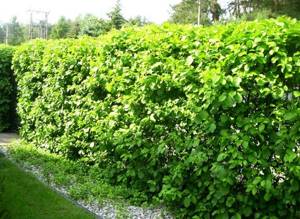
Highlander or Aubert's fallopia
A fast-growing, profusely flowering plant in our climate, Fallopia Aubert grows up to 15 m. It blooms intensively from July to October.
The plant is very fast growing - it gives 6 m of annual growth!
a brief description of
| Height | 15 m |
| Leaves | Small, spear-shaped, green, fall off in the fall after severe frosts. |
| Flowers | Small, white, numerous, form loose, cascading inflorescences of panicles 20-30 cm long. |
Fallopia tolerates poor soils well, but grows much faster in fertile ones. Prefers sunny or semi-shaded places. Planting period in the ground: from March to October.
To stimulate the development of side shoots, cut off the tops of young plants. Older specimens should be pruned 3 times per season. Cut shoots can be used for cuttings.
Application: for covering buildings and high fences, landscaping gazebos, pergolas, various strong supports. Gives a quick covering effect, the best climbing plant if you need to quickly create a curtain of green.

Climbing tree pliers
Tree pliers are a plant from a subtropical climate. In our climate, climbing tree pliers (Celastrus orbiculatus) are grown, characterized by very strong growth and twisting shoots. Picturesque fruits and fabulously yellowing leaves make the plant decorative. The annual growth of shoots can reach 3-4 meters.
a brief description of
| Height | 5-10 m. |
| Escapes | Wrap the supports clockwise. Young shoots are yellow-green. |
| Flowers | The color of the flowers is inconspicuous. Flowering: May-June. |
| Fetus | Appears without additional pollination by a male plant. The fruits are decorative, yellow-red in color. They have the shape of a spherical capsule; when ripe, they open to reveal seeds hidden in a red shell. The fruits create an extraordinary effect, clearly standing out against the background of the gray autumn landscape. |
Wood pliers do not have great soil requirements. These are fast-growing and low-demanding plants. They like fertile, well-drained soil. In soil of lower quality they will cope, but will grow more slowly. It tolerates semi-shaded places well, but grows and bears fruit better in the sun. Frost-resistant. Rarely attacked by pests or diseases. Tolerates urban polluted air and temporary droughts well.

Common hop
The perennial common hop (Humulus lupulus) is a species of climbing plant in the hemp family that has medicinal properties. In nature it grows in damp forests and all kinds of thickets. Its above-ground part dies off in the fall.
a brief description of
| Height | 2-6 m |
| Leaves | 3-5-lobed, heart-shaped at the base, serrated along the edge, rough to the touch, growing oppositely. |
| Stem | Every year, a stem grows from an underground rhizome, bends and twists clockwise, angular, pubescent. |
| Flowers | Dioecious. Female flowers resemble cones, green, without perianth. Male flowers are green-yellow, collected in loose panicles. |
| Rhizome | Strong, with a branched root system. |
| Fetus | nut |
Prefers moist and fertile soils, and when grown in the garden - sunny places. In nature it grows in partial shade. This is a nitrogen-loving plant.
Blooms from June to August.
This is interesting. Hop cones contain lupulin, which is one of the main ingredients in beer. Lupulin has a preservative effect and gives beer its characteristic taste and aroma.

Daurian moonseed
The elegant Daurian moonseed loach (Menispermum davuricum) has excellent decorative and camouflage properties due to the tiled arrangement of leaves. A plant of Asian origin, rarely found in gardens. Every year the shoots grow to 1-2 meters. This is a pest-resistant species whose shoots create a real tangle. Can cover fences, walls, posts and trellises.
a brief description of
| Height | 3-5 m |
| Stem | Green or reddish shoots. |
| Leaves | Round-triangular, disc-shaped, leaf edges slightly curved down. The upper side of the leaf is shiny, bright green, the lower side is bluish. In autumn the leaves change color to bright yellow and then fall off. |
| Flowers | In May-June it blooms with delicate small light flowers. |
| Fetus | Decorative fruits with a diameter of 1 cm are poisonous! |
The seeds of the plant are very decorative, thanks to which it got its name moonseed.
In winter you need to wrap the shoots. Frozen shoots are perfectly restored from the root. Moonseed loves moist soil and sunny places. During periods of drought it should be watered. Fertile soil with a neutral pH (for example, sandy loam) is better suited.
Schisandra chinensis
Liana Schisandra chinensis, belonging to the Schisandra family, has decorative qualities and medicinal properties that are of increasing interest to plant lovers. Great for planting near small openwork fences.
a brief description of
| Height | 5-15 m |
| Stem | Long, thin shoots (up to 5-15 m) |
| Leaves | Large, 10 cm long, shiny, elliptical, dark green. The leaf blade is slightly pointed at the end, gracefully serrated along the edges, and when rubbed gives a pleasant aroma. In autumn the leaves turn yellow and then fall off. |
| Flowers | It blooms in spring (May and June), developing small, pleasantly scented cream or pale pink flowers, collected in small bunches in the axils of the leaves. |
| Fetus | Clusters of round red berries. The fruits ripen in September and are an excellent decoration for the plant and a valuable medicinal material. They are suitable for drying, making jams and juices. |
Schisandra is a dioecious plant, therefore, to obtain beautiful and valuable fruits that appear only on female specimens, at least two specimens of different sexes should be planted in the garden.
Easy to grow. Resistant to low temperatures, does not require winter shelter. It does not like to dry out, so it requires regular watering during drought. It needs a sunny place, fertile, well-loosened, moist soil.

Planting and caring for annual vines
The choice of place of growth must be approached especially carefully - it must be a well-lit area, with nutritious soil, ventilated and without stagnant water. A wooden support is installed for the rose so that the shoots do not freeze in winter. For wintering, it is necessary to insulate the bushes - mulch the roots with sawdust, wrap the lashes in non-woven material. In the spring, sanitary and anti-aging pruning is carried out, removing frozen and old branches.
Despite the different species and cultivars, all perennial loaches obey the basic rules of simple care.
- Installation of support. It must be as reliable as possible, not subject to any external influences.
- Strict adherence to the schedule of watering, fertilizing and pruning.
- Timely weeding and prevention from diseases and pests.
- Beware of planting tall specimens near drains, sewers, wires, or near the foundation of a house. Scourges and roots can damage the integrity of structures.
We offer a huge number of climbing perennials for your choice, including flowering, fruiting and deciduous. By combining different varieties and plants, you can get excellent cozy corners for relaxation, stunning vertical flower beds, and unique garden compositions for your front garden. Some crops will become not only decoration in landscape design, but also a real source of healthy and very tasty fruits.
When planting vines, it is necessary to take care of vertical supports, which can be pegs, branches, fences, and netting. It is advisable to install stands at the time of planting, so as not to later injure the roots of the sprouted plant. Caring for annual vines involves removing shoots that look out of place.
Advanced gardeners often use perennials for propagation as annuals. The specificity of the technique is to get rid of unnecessary worries about wintering and at the same time the desire to vary the appearance of the site every season.
Climbing roses are remarkably beautiful, but very capricious. More often on sale there are semi-climbing, or rambler, with long, strong, non-climbing shoots that bloom once or repeatedly on last year's or current shoots. It is advisable to know all these characteristics about that variety. which you bought. Their winter hardiness varies greatly depending on the variety.
For the winter, the shoots of these roses are gradually bent and tied to a peg, the leaves are torn off, wrapped with a mosquito net from top to bottom so that mice do not eat them, and in late winter, when the temperature drops to minus 7 degrees, the base of the bush is covered with 2-3 buckets of loose compost soil. In the spring, they unplant the bush, but do not rush to lift it, because...
Return frosts can severely damage green leaves. They are raised only when new shoots have already appeared on the plant. Old branches of three to four years of age are cut out almost to the base in the spring. The recently appeared Canadian climbing roses inspire us with cautious optimism; they are unlikely to winter much better. And they bloom very profusely all summer long.
We looked at shrubby perennial vines. Their advantages are very powerful growth, abundance of foliage and often beautiful flowering, but the disadvantage is the possibility of freezing in winter. Subshrubs and herbaceous perennial and annual vines do not have this disadvantage.
Blooming climbing perennials
Winter-hardy crops are used for vertical gardening, hedges, and imitation fences when zoning a site. I advise you to choose unpretentious vines; with regular fertilization, they amaze with lush covers and give rapid growth. Many remain decorative until late autumn; colored fruits complement the autumn crown, which changes colors when it gets colder.
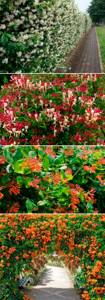
Honeysuckle, American, Brown fuchsia, Dropmore Scarlet variety
Honeysuckle
Among the species diversity, only a few varieties form long lashes that can easily be tied to trellises, walls, and chain-link mesh. Honeysuckle vines prefer fertile soil, good lighting, and regular addition of organic matter and microelements. It is better to purchase plants from local nurseries; they specialize in zoned varieties adapted to weather conditions.
Some types of honeysuckle that are effectively used for hedges:
- Honeysuckle is a vine-like deciduous plant with showy yellow-white flowers with a reddish tint and inedible red or orange berries. Grows up to 6 m. Unpretentious, grows well and tolerates formative pruning well.
- The American one was bred by crossing with honeysuckle and Tuscan honeysuckle. The yellow-purple inflorescences are very fragrant. Afraid of northern cold wind and frost. For the winter, the branches are removed from the trellises and covered. The berries are bright red, inedible.
- Brown fuchsia is a hybrid of two types of honeysuckle: evergreen and rough. White, yellow, cream buds in the form of expanding tubes are collected in a small plume. The fruits are bluish.
- Brown Dropmore Scarlet is another hybrid with bright red clusters of narrow tubular flowers. The climbing plant produces shoots up to 5 meters long. Carmine buds with a white-cream center have a strong aroma that intensifies in the evening. The fruits are red and can be stored until frost.
- Late Serotina honeysuckle is not very long - up to 3 meters, dark red inflorescences fade towards the berry setting phase and become soft pink. Blooms from June to mid-August. The fruits are red. Prone to freezing, it is covered for the winter.
There are many more species and varieties of this beautiful plant.
Remember that climbing honeysuckles with red, orange, and rarely black berries are not edible.
climbing rose
Pleases with fragrant buds from late May to mid-July. Heat-loving, demanding of lighting, fertilizing, watering, pruning (remove all fading flowers). Grows well in neutral, well-drained soil, susceptible to root rot.
Rose and clematis by the fence
Clematis
Liana forming cascades of buds. Varieties with single-row double flowers of pink, white, blue, and light purple colors have been developed. During the flowering period, it is advisable to regularly water and loosen the plant. For the winter, the shoots are cut to 2/3 of their height, the soil is insulated with mulching or covered.
Petiole hydrangea
Rare, but such a picturesque shrub! Owners of fragrant snow-white hydrangeas with dark green leaves will never be disappointed. Bushes are often located along stone walls; the heat-loving vine loves to bask in the sun and is demanding when it comes to watering. Winters calmly in mid-latitudes. Only in winters with little snow does it freeze a little.
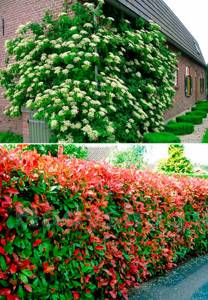
White hydrangea and red lemongrass
Schisandra chinensis
I cannot ignore this common type of hedge. The edible red fruits have medicinal properties, and the curly leaves are added to tea for flavor. Schisandra does not like stagnant water and does not develop well in poor soil. Responds gratefully to pruning.
Wisteria
Delicate lilac inflorescences, reminiscent of grape clusters in shape, continue to bloom all summer. The seedlings are transferred to a permanent place in early spring, at a great distance from each other. The liana gives good annual growth, the branches are immediately fixed so that they do not bend under the weight of the flowers.
The plant is sun-loving and grows well in fertile soil. Fertilizing needs to be done three times per season. Formative pruning is carried out in the fall; in the spring you can cut off the shoots with flower buds. A month before wintering, the plant is allowed to rest; during cold weather, it is removed from the trellis and covered.
Climbing shade-loving plants
Euonymus fortunei or Euonymus fortunei is used to decorate a shaded fence. On lattice supports with the help of aerial roots, these plants are able to rise several meters above the ground. A fence of 3–5 meters is overgrown with euonymus within several years.
Different varieties differ in leaf color:
- Coloratus - with dark green leaves;
- Silver Queen - leaves with a white border, frost-resistant, tolerates frosts down to -25 ° C;
- Sunspot - yellow leaves with green edges.
On the north side, where there is little sun, you can plant climbing hydrangeas or Schizophragma hydrangeoides for landscaping. These fast-growing shrubs, whose branches have aerial roots, are suitable for low fences.
Kirkazon or Aristolochia macrophylla will grow well near a high support in the shade. It has large, beautiful leaves and can be combined with clematis.
Annual climbing plants (names, photos)
Annual climbing plants can also decorate fences and various buildings on a summer cottage. Using these annuals, you can create new compositions every season. All such vines need support, regular feeding, they need sun and light.
Annuals live only one season. As a rule, they are planted early in the spring, but as soon as frosts begin, they die. These plants are convenient for decorating a garden or a small fence, for example, made of mesh, but for one season. Annuals require a lot of attention and are generally very whimsical. They do not like strong temperature fluctuations and require constant fertilization. Some types of annual climbing plants, under favorable conditions, can grow up to 3 meters during the season, thereby forming large green areas. Planting seeds (seedlings) of annuals is carried out in damp soil in the first warm days of spring.
Often, climbing annuals are grown not only in open ground, but also on balconies and country verandas. These bindweeds create shaded areas on hot days; they do not have very powerful roots, that is, they will not spoil the underground part of the structure, and will not constantly grow (boxes are quite suitable for balconies and loggias).
c7e2b3bacdbb3aeab9f41510379e90d2.jpe
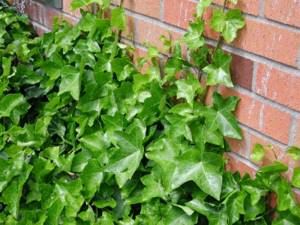
c95a75617a8a1f5d0f50569849e504a7.jpe
Kobeya
We plant kobei seedlings at the dacha in open ground under plastic bottles in mid-May. This vine is great for decorating a fence, pergola or gazebo in the garden. Kobeya grows very quickly, so that by July the fence will turn into a beautiful carpet, which in the fall (or closer to it) will be decorated with white, crimson, purple and pink flowers that look like small gramophones. The liana is not very picky about care. It requires periodic watering and fertilization. All of the above is also suitable for morning glory.
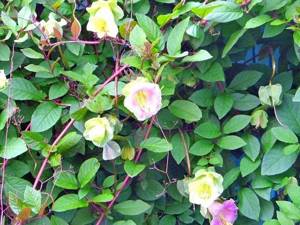
Sweet pea
Any novice gardener can grow it on their own plot. Sweet peas bloom very beautifully, they have a wide range of colors, and they exude an exquisite aroma for about 4 months. You can use it to decorate small fences.
Climbing peas are not afraid of spring frosts, so they can be planted early in the spring. The loach needs to be provided with timely support. Otherwise, its fragile lashes will intertwine with each other, and it will be quite difficult to untangle them. In order for this climbing plant to delight with its flowering for a long time, it is necessary to promptly trim off excess shoots, water it and remove faded inflorescences.
The nuances of choosing fast-growing climbing plants for the garden: photos and names
Many ornamental annuals are also fast-growing and can be used to decorate fences. Popular perennials include hops, which grow quickly in the summer. Also worth noting is honeysuckle and clematis. To provide quality care, they need to be tied up, since young shoots grow very quickly.
Before choosing fast-growing climbing plants for your fence, consider some important points:
- what the fence is for;
- plants, what height should be chosen;
- how much free space are you willing to spend on landscaping;
- single-tier or multi-tiered fence.
Weaving compositions can also be placed in pots. In this case, exotic crops can also be used. When cold weather sets in, you will quickly bring them indoors
Also consider these important conditions:
- type of soil on the site;
- location of moisture;
- how often does precipitation occur;
- shaded or sunny area;
- How windy is it in your area?
Plants that can reach a height of up to three meters are most often used for fencing. It is not necessary to use plants of the same height when creating a hedge. You can try to build a multi-tiered composition. In this case, you need to select plants that will not obscure each other and also match in color.

When choosing combinations of plants, it is important to take into account the color palette when flowering
There are crops that need additional support. For example, a picket fence, a chain-link mesh or a brick wall. Crops that do not require supporting elements can be used to decorate a large space.
Creepers deserve special attention, as they can entwine strong structures and trees. These plants go well with small architectural structures, such as gazebos, pergolas and arches.

Using climbing crops you can create luxurious gazebos
I plant annual crops in early spring, but they only live for one season. With their help you can decorate a small fence. Such plants require careful care. Climbing annuals can be planted not only in open ground, but also on country verandas or even balconies.

Exquisite decor for the veranda
Climbing perennials often require special supports. To do this, you can use trellises or corners. The best support is a fence.
For your information! Free-growing plantings take up much more space, but they can still bloom and bear fruit.
Related article:
A fast-growing perennial evergreen hedge. An overview of coniferous and deciduous plants for creating a beautiful hedge yourself, examples of beautiful solutions and care tips in a special publication.
Selection of flowering perennial vines
So, let's look at popular climbing crops.
Actinidia planting and care: photos of beautiful flowers
Actinidia is a perennial vine. The plant has beautiful variegated foliage. For full development, culture requires special support. The flowers of this culture are white and have no smell. Do you know that actinidia produces tasty fruits that can be eaten fresh. Planting can be done in spring or summer.
There are different varieties of this crop. Let's figure out what is better than actinidia argut or kolomikta.

Gardening with actinidia kolomikta
Arguta is one of the most powerful varieties. Its length can reach 30 meters. White inflorescences bloom on the plant. The fruits have a spherical shape. They are completely edible and have a laxative effect.
The main advantage of kolomikta is its resistance to frosty weather. In this case, the plant can reach 10 meters in length. In the silt, the leaves become whitish, and then change the palette from pink to crimson. And in autumn the foliage turns yellow-pink and red-violet.
You can take a better look at this variety in this video:
Both plants can be used for landscaping fences. It is worth considering their size and coloring. In addition, the fruits of arguta will be larger than those of kolomikta. But many gardeners claim that the fruits of the latter are more useful. Warm climates are more suitable for both varieties.
For your information! This crop does not tolerate being near apple trees. Proper crop care is also important, which includes weeding, pruning and fertilizing the plants.
Bougainvillea: cultivation and care
Bougainvillea is a vine, shrub and tree. It is not the flowers themselves that are decorative, but their subflowers. They can be of various shapes, as well as colors: from lilac to white. Particularly popular are varieties such as Peruvian, naked and beautiful. This crop is suitable for cultivation in the southern regions. And in other areas, it can only be grown in pots and taken out into the garden in warm weather. The tubs can also be placed near fences, but with the onset of cold weather, the plant must be removed to a warm room.

Stunning bougainvillea colors
When growing such a plant, it is necessary to regulate the growth of shoots. For this purpose, special trimming is used. This procedure can be performed in the fall, when the plants are removed to a warmer place. In this case, cutting is done by half. And in the spring, cutting branches to 10 cm will ensure better bushiness. During the growing season, weak growth is removed.
In the video you can see different types of this culture.
Chinese wisteria: planting and care
Wisteria is a tree-like plant, or rather a vine with clusters of purple, scarlet and white flowers. There are also varieties that are frost-resistant, but in very cold winters such plants freeze out. Wisteria shoots can densely cover various tall structures, such as fences or walls. The culture blooms from May to July, and with proper care, even in September. The Chinese variety includes several varieties. Most plants have a lilac purple color, but there are also varieties with white double flowers.
Luxurious wisteria is used to decorate arches and fences
Wisteria is often used for vertical landscaping such as fences and walls. It is important for her to provide strong and high-quality supports. All young shoots need to be tied up . Pruning is also used to form the crown.
You can watch the features of growing wisteria in this video:
For your information! This culture is light-loving. The area with this plant should be illuminated for at least 5 - 6 hours a day. It is better to plant near the fence, which is located on the south side.
Decorative climbing honeysuckle: types and description
There are more than 250 varieties of honeysuckle in nature. Vertical gardening is done using long vines that can grow up to 5 meters. All ornamental plants have fruits that should not be eaten. But they have a lot of other advantages. They have luxurious dense foliage, as well as abundant flowering and bright decorative fruits. With the help of such plants you can wonderfully decorate any type of hedges. It should be taken into account that this crop requires fertile soil.
For fencing, you can choose the following varieties of decorative honeysuckle:
- fragrant honeysuckle honeysuckle can climb along a fence to a height of 6 meters. This is a frost-resistant version of honeysuckle. This plant is light-loving and also demanding of fertility and humidity. The inflorescences of the plant have a reddish, yellowish and white palette. In this case, the flowering period lasts about 15 days;
- Brown's honeysuckle can reach 5 meters. The leaves of the crop have an elliptical shape. In this case, the upper part of the leaf is bright green, and the back is bluish. Honeysuckle blooms with gorgeous red flowers. This wonderful period lasts about three weeks;
Garden decor made from unusual honeysuckle
- Henry's honeysuckle grows up to 2.5 meters. It blooms with bright pink and brown-red flowers. The plant tolerates shade well;

This is what this type of culture looks like
- Hekrota honeysuckle along a hedge can rise to a height of up to 4 meters. It is distinguished by two-color inflorescences, which are pink-orange on the outside and yellowish or creamy on the inside. In this case, flowering lasts from June to September.

Honeysuckle Hekrota during flowering
See how to grow this amazing crop:
For your information! These species reproduce using layering, cuttings, and seeds. But the latter method does not provide high germination.
Campsis rooting: nuances of cultivation
There are special secrets when growing rooting campsis. The winter hardiness of this plant allows it to be planted even in cool regions. The plant is a deciduous perennial vine. Can climb high up a spacious hedge. At the same time, its shoots wrap around the supports in the form of a spiral. Luxurious scarlet and orange tubular flowers form on the stems. Flowering occurs from June to September.
Campsis attaches well to inclined or vertical supports. This is a great solution for decorating a fence. Curly options are excellent for shrub forms.

Rich palette of Kampsis
For your information! From this plant all kinds of figures are made on a frame in the form of pyramids or balls. Such crops are common in Europe, and in Russia, mostly in the Moscow region.
See how to properly care for your crop:
Honeysuckle: photos of luxurious compositions
The name of the honeysuckle variety, honeysuckle, translates as goat leaf. This plant has light green shoots, which in the sun can take on a pinkish-red hue. Flowers on tall tubes have a strong aroma. Flowering lasts about a month. This produces orange berries. But they are inedible.
The liana must be planted in sunny areas with low groundwater. In this case, the soil can be light, created on the basis of humus. Honeysuckle is great for shaping. The plant also tolerates slight shading well. Plant the vine only in fertile soil that has been previously moistened. Planting should be done in April, but no later than this month. Reproduction is best done by shoots. If you want to plant several vines at once, make a small trench. When planting, use mulch, which will retain moisture and also prevent the spread of weeds.
Dense planting of honeysuckle
In order for the plant to develop and grow well, it is necessary to properly prepare the soil. It should be loose so that air penetrates well into it.
For your information! If honeysuckle takes root with you, then it is not afraid of dust and environmental conditions. It will grow for a very long time, about 50 years.
Kirkazon Manchurian: secrets of care
Exotic flowers of Kirkazon vines will be a wonderful decoration for any fence. With proper care they can grow in our climatic conditions. If you decide to grow them, you need to know that such a crop begins to bloom only in the fifth year.
Maintenance is not difficult, it is important to water regularly. Don't wait until the top layer of soil dries out. Formative pruning needs to be done periodically. At the same time, long shoots that protrude above the fence must be cut off in time. You also need to remove all dried branches. Planting is best done in spring or autumn. In this case, the seedlings should be 2-3 years old.

Design of arched compositions
A solution of mullein is suitable as a top dressing. The crop can be planted in the shade, but it must be provided with sufficient moisture. Watering should be regular, and in hot weather, humidify the air.
Perfectly suitable for various vertical gardening options. And also for decorating gazebos, arches, balconies and columns.
For your information! Caring for such a crop should include mulching and loosening the soil. Half-ripe leaves are suitable as mulch.
Clematis: planting and care in open ground
Clematis is also an unpretentious vine. It blooms beautifully and is great for decorating fences. Planting should be done in spring and preferably in shaded areas. It is also worth choosing a place where groundwater does not pass close to the surface of the earth. You can plant the plant on a small hill.

Magnificent clematis for decorating a fence
During cold weather, plantings need to be covered to prevent them from freezing. Do not forget to remove weeds around the bushes, as they take away all the necessary moisture. You need to sow lawn grass around the bushes.
Clematis can also be used to decorate beautiful gazebos. The bush begins to curl from the stems. It is also used to decorate arches and alpine slides, since this plant can spread in the form of a carpet.
In landscape design, such crops can be used in combination with other ornamental crops. At the same time, you can create original compositions with a complex structure.
See how to care for clematis below:
Tall varieties curl beautifully around supporting elements. Pairs perfectly with roses. You can also add them to rosehip and lilac bushes.
It is recommended to plant the crop in the spring. In this case, the distance between the shoots should be about a meter. Consider a high-quality drainage system that will protect the seedlings from rotting of the root system. Also remove weakened shoots in a timely manner.
For your information! Before planting seedlings, inspect the roots. If they look a little dry, then put the bush in water for a couple of hours.
Prince of Siberia: crop care
This culture is primarily popular due to its medicinal properties. The Siberian prince is also used to decorate all kinds of hedges. The crop can be planted both in May and September. In this case, special care should be taken, since the plant has a fragile root system.
Unusual flowering of the prince
There are a number of pests that are dangerous to this crop. For example, slugs. They need to be removed manually. Damaged branches should be removed.
The characteristics of this culture can be seen below:
Schisandra chinensis: cultivation and care
Beginners in gardening are afraid to take on the cultivation of this crop. But experienced gardeners say that there is nothing complicated about it. And you just need to follow certain rules:
- the crop requires lighting of at least 8 hours per day, which is why it is so important to choose an open area;
- the plant reacts poorly to windy weather, as various diseases may appear;
- Since the plant is climbing, it is important that there are supports nearby to which it will be attached.
Bright lemongrass fruits
Schisandra also requires special care, including pruning, crown formation and gartering of shoots.
You can learn the secrets of caring for lemongrass from the video below:
White step (bryonia): photos of the best compositions
White Bryonia is a perennial that is often planted near hedges. At the same time, the vines cling to it and rise up. Interestingly, the seeds can be planted immediately in open ground and at the same time before winter. Bryonia feels good both in the sun and in the shade. In order for the plant to fully develop, moderate watering is necessary. Feeding will also not hurt. You can use organic or mineral fertilizers.

Bryonia flowering
Important! Consider whether you need this plant on your site, since it is absolutely poisonous. Please pay particular attention to this warning if you have children or pets. But in folk medicine it is used to treat radiculitis and gout.
Climbing rose: plant photo
Let's look at the features of planting and caring for climbing roses, a photo of which you can see on the website. The bushes grow well and also cover large areas. This flower prefers good lighting. But it is important that the plantings are not exposed to the sun all day. Do not over-water the plant or plant it in swampy areas. As a top dressing, it is better to use special solutions of complex fertilizers that can be sprayed on the leaves. It is better not to use this procedure during flowering periods. When planting seedlings, it is recommended to step back half a meter from the fences.
This is how it is grown:
For your information! With the help of a climbing rose, you can disguise ugly facades of buildings, and also decorate an old tree. This is an excellent solution for zoning an area. You can braid the frame of a canopy or gazebo with roses.

Luxurious vertical design
Spiraea rowan leaf: how to grow
Spiraea rowan leaf is an ornamental crop that appeared in the Far East. The plant grows in a short time, but its height rarely exceeds two meters. The interlacing of the stems allows you to create fairly dense thickets.

Fence design option
Rowan-leaved spirea is called so because its leaves resemble those of rowan. The flowering time begins in July and lasts about a month. By autumn the leaves turn purple and yellowish. The bush should be planted in a semi-shaded or sunny place. It tolerates drought quite well and also takes great care of watering. Reproduction occurs using root shoots.
See what this plant looks like in the video:
Eccremocarpus: nuances of cultivation and care
Eccremocarpus requires special care, as it is not very frost-resistant. The plant is a magnificent vine with bright flowers. Suitable for decorating all kinds of hedges. The culture is distinguished by thin and elegant vines that wrap well around the supporting elements. Such plants can form continuous coverings on fences.
The flowers of this culture come in orange and red tones. It is popular among gardeners due to its long flowering period, which can last for 2.5 months. Exotic vines look good on trellises, fences and various arches. Can be used as a background and for the background.

Plant in flowering period
It is grown as an annual plant, as a biennial plant, and also as a perennial crop. In any case, it is better to plant the plant on the south side of the fence, as it prefers good sunlight. Planting can be done at intervals of 30 cm.
For your information! The plant may suffer from aphid attacks. To rid him of this scourge, use a soap solution.
Echinocystis: photos of luxurious flowers
Echinocystis is great for decorating walls and fences. It does not require special care conditions, but the crop is resistant to drought. The plant can withstand frost.

The fruits look scary up close
People call it the mad cucumber. It is quite common in our country and is even grown in cold regions. The liana has stems reaching a length of 6-10 meters. Non-acidic, moisture-permeable and light soils are suitable for Echinocystis. In dry weather, watering is required, 4-5 liters per bush. Excellently adapts to specific growing conditions. This plant is also medicinal. It is used in folk medicine due to its strong diuretic, laxative and anthelmintic properties. But you need to know the proportions of application, since the plant is considered poisonous.
Watch the video below to learn about the growing features:
How to choose decorative deciduous perennial vines for a fence
Decorative deciduous vines have the following advantages:
- thickly and quickly braid fences, and also fill gaps in the fence well;
- caring for such plants is not difficult;
- does not require a large amount of soil.
Let's find out which plants are best to choose for your summer cottage.
How to choose plants, see below:
Amur breakthrough grapes: description of culture
First of all, an important advantage of Amur grapes is its resistance to frost. It can even withstand temperatures down to minus 40. This variety grows quickly, and the length of the vine can reach up to 35 meters.

Grape fruits in autumn
The plant feels good in any soil, but it is better to choose an acidic soil. Sunlight has a beneficial effect on this crop, so it is worth choosing a lighted area. When planting seedlings, a distance of 1.5 meters must be maintained.
Look at a short overview of this culture:
Maiden grapes: planting and care
Maiden grapes include about 19 varieties. It can also grow in the shade, but it can change the color of the leaves to yellow or burgundy. The crop can be planted both in autumn and spring. In this case, it is necessary to maintain a gap of 1 meter. For quality care, it is necessary to perform pruning and shaping . Young shoots need to be directed to the fence so that they cling for further development.

Beautiful grape shoots
Round-leaved tree pliers: photos of flowers
The round-leaved tree pliers are also represented by vines. In this case, the height of the weaving can reach 12-18 meters. Over the course of a season, the plant can add 1 to 2 meters. An excellent solution for fences and fences. For planting, you should choose a well-lit place.
Here is a short video about this plant:
It is necessary to water while the seedlings are young. And this plant is characterized by resistance to humidity. It is recommended to perform pruning in spring.

Dense planting
Rules for choosing annual climbing plants for a fence
Ornamental fencing annuals make excellent hedges. Such crops can reach considerable heights, which allows them to be used as decoration for fences.
Annual crops live only one season, during which they acquire leaves and spread throughout the entire fence. But with the onset of frost they die. There are some annuals that require minimal care and can withstand even a light frost. These are decorative beans and sweet peas. Initially, young shoots must be tied up until they catch on the fences. A chain-link mesh is ideal.
Annual sweet pea: growing from seeds
Common options include annual sweet peas. Planting and care, photos of beautiful decor can be viewed and studied on the website. The propagation process of this crop occurs using seeds. In this case, the plants reach a length of two meters.
Peas are endowed with thin stems that are perfectly attached to various fences. You can direct the shoots in the desired direction. There are various varieties of this plant.

Vertical gardening option
For your information! Pea inflorescences immediately respond to temperature changes. In this case, they may not even appear.
You can see about this culture below:
Morning glory: planting and care, photo compositions
Morning glory is often used to improve landscape design and hedges. Even beginners can plant and care in open ground. Lianas can reach a height of five meters. Such plantings can perfectly camouflage the fence. The decoration is made up of beautiful flowers, which can vary in different colors. Flowers open in the morning and close in the evening.
Magnificent bloom
It is better to plant this plant in May - June, when frosts are no longer expected. You can also use perennial morning glory. Planting and care will differ from annuals.
See below for how to plant morning glory:
Ipomoea purpurea: planting and care, photo of flowers
Ipomoea annua has a pubescent stem. Planting and caring for the plant is not particularly difficult. The plant can reach a height of about 8 meters. The flowers come in a varied palette: white, blue and red. There are terry and variegated colors.
Since annual varieties come from countries with a tropical climate, they do not tolerate frost. Morning glory should be watered regularly. But at the same time, liquid should not be allowed to stagnate in the root system. It is recommended to fertilize every 2-3 weeks. Excessive dosages of fertilizers can cause thick foliage, but flowering will not occur.
Purple option
Kobeya climbing: growing from seeds
In our review you can see photos of the Kobei. Planting and caring for a crop requires preliminary study. This crop can grow up to 6 meters high, especially if it clings to a hedge. The flowers are purple and white in color and can be about 8 cm in size.
In order for a plant to grow quickly, a sufficient amount of nutritional components is necessary. It is also important to provide high-quality lighting.

Kobeya for landscape design
For your information! Tie young shoots to small supports, and then they themselves will cling to the ledges of the fence.
See how to grow it below:
Nasturtium climbing: photos of flowers, how to plant
You can try using nasturtium for decoration. Planting and care is accessible even to novice gardeners. The length of the plant stems can reach two meters. The flowering period of the crop will also please you; it lasts from June to August. Almost any soil is suitable for the plant. Do not overuse organic fertilizers, and also provide the vine with sufficient lighting.

Flowering period
Growing nasturtium from seeds is especially popular. Many experienced gardeners know when to plant seedlings. This is April or May. The plant does not require special care. Water the sprouts, especially at first.
See how to grow nasturtium correctly:
Decorative beans: nuances of care
Decorative climbing beans are great for decorating hedges. Planting and caring for this crop is not so difficult. A beautiful plant will be a great decoration for any area. If you provide decorative beans with proper care, the climbing stems will reach a height of up to 5 meters. This culture prefers a lot of light. The decorative option has a large number of varieties. Unlike regular beans, these fruits cannot be eaten.

This is what beans look like that you shouldn't eat
The nuances of choosing climbing shade-loving plants
In addition to such parameters as light, plants require certain conditions for soil and care. There are crops that thrive in dense shade, and there are vines that require diffuse shade.
Evergreen garden ivy: care features
Luxurious design of all kinds of fences requires compliance with the correct planting and care of garden evergreen ivy. This crop thrives in any lighting conditions. It can be planted both in open areas and in semi-shaded areas. While the plant is still young, it requires careful monitoring, as it can die if it grows too actively.

Dense barrier
For your information! Ivy is susceptible to many garden diseases. You can recognize the disease by the following symptoms: yellowing and falling leaves, as well as a faded appearance of vegetation.
Video: how to plant ivy correctly
Hops: planting and care in open ground
Hops are used not only for the production of beer, for medicinal and food purposes, but also for excellent landscaping of fences. Hops are perennials, and their shoots grow very quickly and can grow up to 7 meters.
Ordinary hops are a winter-hardy crop; it is from its cones that beer wort is produced. The plant is dioecious, meaning there are male and female flowers.

Hop fruits
Japanese hops are a creeping annual. It has a more sophisticated look. Unlike the ordinary variety, which climbs along supporting elements, it is able to cover the hedge with a dense and luxurious curtain. Hops grow well. To create a hedge, it needs to be planted at a distance of two meters from the fence. Can decorate arches and all kinds of gazebos.
This plant feels comfortable in partial shade. At the same time, choose nutritious soil rich in humus. Before planting, it is recommended to treat the soil with compost or manure. Select a suitable place near the fence and make a depression of about 30 cm. Then the soil should be mixed with compost, and then the seedling should be placed in the hole. In this case, the earthen lump should be flush with the ground.
If plaque or spots appear, the affected leaves must be removed and the plant treated with a fungicide. Be sure to help the plant weave along the fence. To do this, wrap the shoots around ledges and supports.
For your information! It is recommended to plant hops with other climbing crops. Especially goes well with climbing roses.
Related article:
Fences for private houses: photo ideas A separate publication presents original ideas and examples of fences made of different materials to suit every taste.
